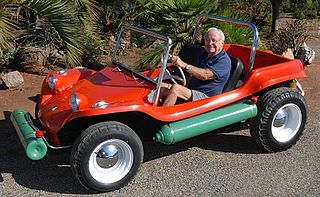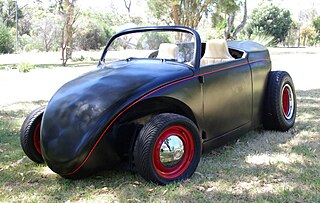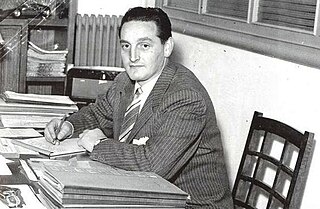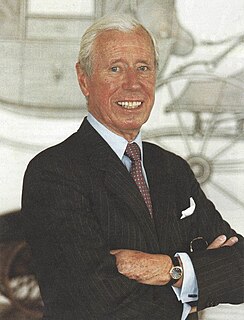
The Porsche 914 or VW-Porsche 914 is a mid-engined sports car designed, manufactured and marketed collaboratively by Volkswagen and Porsche from 1969 to 1976. It was only available as a targa-topped two-seat roadster powered by either a flat-4 or flat-6 engine.

The Volkswagen Beetle—officially the Volkswagen Type 1, informally in German the Käfer, in parts of the English-speaking world the Bug, and known by many other nicknames in other languages—is a two-door, rear-engine economy car, intended for five occupants, that was manufactured and marketed by German automaker Volkswagen (VW) from 1938 until 2003.

The Volkswagen Karmann Ghia is a sports car marketed in 2+2 coupe (1955–1974) and 2+2 convertible (1957–1974) body styles by Volkswagen. Internally designated the Type 14, the Karmann Ghia combined the chassis and mechanicals of the Type 1 (Beetle) with styling by Italy's Carrozzeria Ghia and hand-built bodywork by German coachbuilding house Karmann.

A lowrider is a customized car with a lowered body. These customized vehicles are generally individually painted with intricate, colorful designs, rolling on wire-spoke wheels with whitewall tires. Lowrider rims range from 13". They are also fitted with hydraulic or air bag systems that allow height adjustable suspension, where the vehicle is raised or lowered at the owner's command. Given these specific characteristics, while a lowrider is always a lowered car, a lowered car is not always a lowrider. The term is used to describe a class of vehicle, not simply the height from ground to chassis.

Wilhelm Karmann GmbH, commonly known as simply Karmann, was a German automobile manufacturer and contract manufacturer based in Osnabrück.
Virgil Max "Ex" Exner Sr. was an automobile designer for numerous American companies, notably Chrysler and Studebaker.

The Volkswagen Type 3 is a compact car that was manufactured and marketed by Volkswagen from 1961 to 1973. Introduced at the 1961 Frankfurt Motor Show, Internationale Automobil-Ausstellung (IAA), the Type 3 was marketed as the Volkswagen 1500 and later as the Volkswagen 1600, in three body styles: two-door Notchback, Fastback and Variant, the latter marketed as the 'Squareback' in the United States.

In automotive design, an RR, or rear-engine, rear-wheel-drive layout places both the engine and drive wheels at the rear of the vehicle. In contrast to the RMR layout, the center of mass of the engine is between the rear axle and the rear bumper. Although very common in transit buses and coaches due to the elimination of the drive shaft with low-floor bus, this layout has become increasingly rare in passenger cars.

The Volkswagen New Beetle is a compact car, introduced by Volkswagen in 1997, drawing heavy inspiration from the exterior design of the original Beetle. Unlike the original Beetle, the New Beetle has its engine in the front, driving the front wheels, with luggage storage in the rear. Many special editions have been released, such as the Malibu Barbie New Beetle.

The Meyers Manx dune buggy is a small recreationally-oriented automobile, designed initially for desert racing by Californian engineer, artist, boat builder and surfer Bruce F. Meyers. It was produced by his Fountain Valley, California company, B. F. Meyers & Co. from 1964 to 1971, in the form of car kits applied to shortened chassis of Volkswagen Beetles. The car line dominated dune racing in its time, breaking records immediately, and was eventually also released in street-oriented models, until the company's demise due to tax problems after Meyers's departure. New vehicles inspired by the original Manx buggy have been produced by Meyers's re-founded operation, Meyers Manx, Inc., since 2000. The name and cat logo of the brand derives from the Manx cat, by virtue of the tailless breed's and the shortened vehicle's truncated "stubbiness".

The Volkswagen Type 181 is a two-wheel drive, four-door, convertible, manufactured and marketed by Volkswagen from 1968 to 1983. Originally developed for the West German Army, the Type 181 also entered the civilian market as the Kurierwagen in West Germany, the Trekker in the United Kingdom, the Thing in the United States (1973–74), the Safari in Mexico and South America, and Pescaccia in Italy. Civilian sales ended after model year 1980.

The Volkswagen Brasília is a rear-engined compact car, manufactured and marketed by Volkswagen in Brazil between 1974 and 1982; in Mexico from 1975-1982; and as knock down kits in Nigeria where it was marketed as the Igala from 1976–1980.

Volksrods are modified Volkswagen beetles. They are used as an alternative to traditional Ford-based hot rods. Classic Ford Model Ts and Model As are becoming more scarce and more valuable than ever. VW Beetles are much more affordable, easier to find, and easier to find parts for. It is also a 1930s design, which is well-suited to hot-rodding's roots and tradition.

Luigi "Gigi" Segre was an Italian automotive designer noted for his business and engineering acumen during his stewardship and ownership of Carrozzeria Ghia (1953–63), one of an Italy's premier automobile design and coachbuilders.

In automobile design, a rear-engine design layout places the engine at the rear of the vehicle. The center of gravity of the engine itself is behind the rear axle. This is not to be confused with the center of gravity of the whole vehicle, as an imbalance of such proportions would make it impossible to keep the front wheels on the ground.

The Volkswagen Golf Mk1 is the first generation of a small family car manufactured and marketed by Volkswagen. It was noteworthy for signalling Volkswagen's shift of its major car lines from rear-wheel drive and rear-mounted air-cooled engines to front-wheel drive with front-mounted, water-cooled engines that were often transversely-mounted.

The Volkswagen Beetle was introduced to Mexico in March 1954, inside the exhibition "Alemania y su Industria". Four different Volkswagen vehicles were brought to Mexico through Veracruz City for the first time. Those vehicles were: two Sedans 113 in "Export" trim, a convertible, and a VW Bus in luxury trim. Officially, the Bug/Beetle was named "Type I sedan" and the Bus was named "Type II station wagon", though variants included single and double cab pickups.

A Cal-Style VW is a lowrider-influenced vintage Volkswagen, that for style and cruising was lowered to the extreme in the manner called "dumped" "slammed" or "laid out". The Cal-Style VW originated in the streets of Los Angeles in the late 1970s, when the first generation of teens from Latino neighborhoods veered away from the Low Riders that at the time were associated with gangs and criminal activity, and instead customized their economical VWs into lowriders for the cruising and teen subculture.

Karosserie Friedrich Rometsch, a German metallurgical-coachbuilding company based in Berlin-Halensee, manufactured, modified, and repaired coaches, trailers, bodies and chassis.

Wilhelm Karmann Jr. was a German entrepreneur. He took over the management of Wilhelm Karmann GmbH based in Osnabrück in 1952 and led the company to become a recognized partner of the automotive industry as a contract manufacturer of complete vehicles and as a supplier of pressed parts, production systems and roof modules for convertibles. He was also involved in numerous vehicle developments.



















